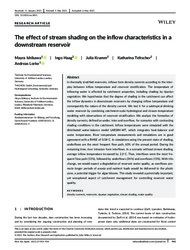The effect of stream shading on the inflow characteristics in a downstream reservoir
DOI: https://doi.org/10.1002/rra.3821
Persistent URL: http://resolver.sub.uni-goettingen.de/purl?gldocs-11858/9842
Persistent URL: http://resolver.sub.uni-goettingen.de/purl?gldocs-11858/9842
Supplement: https://doi.org/10.5281/zenodo.4746288
Ishikawa, Mayra; Haag, Ingo; Krumm, Julia; Teltscher, Katharina; Lorke, Andreas, 2021: The effect of stream shading on the inflow characteristics in a downstream reservoir. In: River Research and Applications, Band 37, 7: 943 - 954, DOI: 10.1002/rra.3821.
 |
Dokument öffnen: |
In thermally stratified reservoirs, inflows form density currents according to the interplay between inflow temperature and reservoir stratification. The temperature of inflowing water is affected by catchment properties, including shading by riparian vegetation. We hypothesize that the degree of shading in the catchment can affect the inflow dynamics in downstream reservoirs by changing inflow temperature and consequently the nature of the density current. We test it for a subtropical drinking water reservoir by combining catchment‐scale hydrological and stream temperature modeling with observations of reservoir stratification. We analyze the formation of density currents, defined as under, inter and overflow, for scenarios with contrasting shading conditions in the catchment. Inflow temperatures were simulated with the distributed water‐balance model LARSIM‐WT, which integrates heat‐balance and water temperature. River temperature measurements and simulations are in good agreement with a RMSE of 0.58°C. In simulations using the present state of shading, underflows are the most frequent flow path, 63% of the annual period. During the remaining time, river intrusion form interflows. In a scenario without stream shading, average inflow temperature increased by 2.2°C. Thus, interflows were the most frequent flow path (51%), followed by underflows (34%) and overflows (15%). With this change, we would expect a degradation of reservoir water quality, as overflows promote longer periods of anoxia and nutrient loads would be delivered to the photic zone, a potential trigger for algae blooms. This study revealed a potentially important, yet unexplored aspect of catchment management for controlling reservoir water quality.
Statistik:
ZugriffsstatistikSammlung:
- Geographie, Hydrologie [454]
This is an open access article under the terms of the Creative Commons Attribution License, which permits use, distribution and reproduction in any medium, provided the original work is properly cited.

